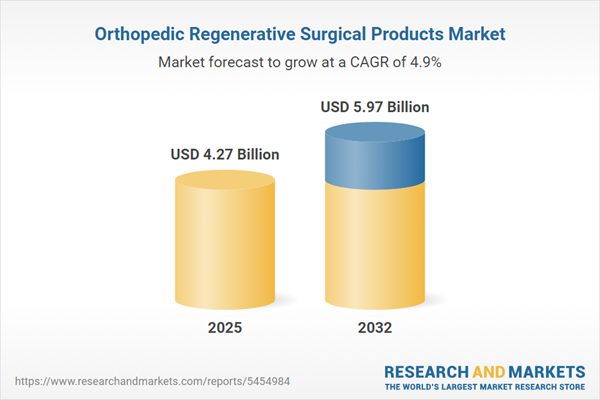Speak directly to the analyst to clarify any post sales queries you may have.
The orthopedic regenerative surgical products market is undergoing significant transformation as hospitals and care networks shift procurement strategies to meet evolving clinical demands. Senior decision-makers are focusing on innovation and operational agility to navigate complex musculoskeletal care requirements and position their organizations for sustained growth.
Market Snapshot: Orthopedic Regenerative Surgical Products Market Growth
The orthopedic regenerative surgical products market is experiencing steady advancement, expanding between 2024 and 2025 from USD 4.07 billion to USD 4.27 billion, with a compound annual growth rate (CAGR) of 4.89%. Forecasts point to further acceleration, and the market is anticipated to reach USD 5.97 billion by 2032. This positive direction is influenced by robust investor confidence, widespread adoption of minimally invasive surgery, and increasing demand from healthcare organizations aiming to deliver superior patient outcomes. As procedural requirements evolve, companies are realigning product offerings and engaging in strategic partnerships to deliver leading-edge regenerative solutions. These factors collectively indicate broad opportunities for senior leaders focused on continuous improvement and adapting to shifting clinical practices.
Scope & Segmentation: Orthopedic Regenerative Surgical Products Market
This detailed report offers segmentation designed to equip executives with actionable insights for precise growth planning and procurement optimization. Segment relevance, technology application, and regional market shifts are addressed to support sound decision-making.
- Product Types: Demineralized bone matrices are vital for bone repair, and allografts—both injectable and structural—serve intraoperative needs. Stem cell therapies enable targeted musculoskeletal interventions. Bone morphogenetic proteins and platelet-derived growth factors support effective soft tissue repair. Solutions using ceramics, composites, and engineered polymers allow for procedural precision, meeting diverse surgical needs.
- Applications: The range of uses includes alveolar ridge augmentation, implant stabilization, periodontal procedures, large joint reconstruction, spinal fusion, trauma management, and multi-site fracture repair. These applications support a breadth of care environments, aligning with regulatory guidelines and clinical best practices.
- End Users: Major users are ambulatory surgical centers, multi-specialty hospitals, academic medical institutions, outpatient clinics, group practices, and specialized orthopedic facilities. Each requires tailored solutions to enhance workflow, efficiency, and patient care quality.
- Regions: Coverage extends across North America, South America, Europe, the Middle East, Africa, and Asia-Pacific. Leading adoption is observed in the United States, Canada, United Kingdom, Germany, Brazil, China, India, Australia, Mexico, and Argentina. Reimbursement policies and local protocols in these regions play a crucial role in shaping demand.
- Technologies: Advanced techniques include cellular therapies, growth factor application, digital surgical planning, engineered scaffold materials, and additive manufacturing. Uptake depends on regulatory frameworks, technology readiness, and workflow integration, with regional variations influencing clinical adoption.
Key Takeaways for Senior Decision-Makers
- Adoption of minimally invasive solutions streamlines orthopedic surgical workflows and enables high standards of procedural consistency for musculoskeletal treatment.
- Strategic partnerships between biotechnology innovators and device firms are boosting product development speed and facilitating wider access to advanced regenerative methods.
- Regulatory changes are making it easier for next-generation orthopedic technologies to reach the market, which in turn broadens their clinical uptake among top-tier providers.
- Enhancing supplier networks and expanding manufacturing within key regions strengthens supply resilience and insulates organizations from disruptions related to shifting international dynamics.
- Sustained clinical research efforts are building trust among clinicians and payers, leading to broader acceptance of regenerative procedures across care pathways.
- Customizing offerings for local guidelines and procurement priorities increases both provider loyalty and differentiation in heterogeneous markets.
Tariff Impact: Cost and Supply Chain Management
Recent tariffs in the United States affecting biologic materials, scaffolds, and specialty alloys are driving up costs and highlighting supply chain vulnerabilities. Organizations are addressing these challenges by fortifying supplier relationships, expanding manufacturing in targeted markets, and collaborating with local tissue banks and contract manufacturers. Initiatives in strategic sourcing and nearshoring are utilized to stabilize supply, ensure regulatory compliance, and maintain product availability for care providers. Effective risk mitigation is crucial for sustaining stakeholder confidence and uninterrupted patient care in the context of tariff-related pressures.
Methodology & Data Sources
This analysis is grounded in comprehensive secondary research, with validation from regulatory experts, direct feedback from surgeons, procurement leaders, and academic specialists. Scenario modeling and consensus-based approaches underpin the report’s recommendations for executive decision-makers navigating the orthopedic space.
Why This Report Matters: Strategic Value for B2B Leadership
- Guides executive teams in optimizing orthopedic portfolios and efficiently integrating regenerative technologies to address changing clinical standards and procurement needs.
- Provides informed strategies for navigating evolving regulations and complex supply chains, supporting business resilience and long-term success.
- Enables manufacturers, suppliers, and stakeholders to identify new opportunities and establish a strong position in both regional and global markets.
Conclusion
This report offers senior leaders the insights necessary to support innovation, foster strategic growth, and address the evolving demands of the orthopedic regenerative surgical products market.
Additional Product Information:
- Purchase of this report includes 1 year online access with quarterly updates.
- This report can be updated on request. Please contact our Customer Experience team using the Ask a Question widget on our website.
Table of Contents
3. Executive Summary
4. Market Overview
7. Cumulative Impact of Artificial Intelligence 2025
Companies Mentioned
The companies profiled in this Orthopedic Regenerative Surgical Products market report include:- DePuy Synthes, Inc.
- Stryker Corporation
- Zimmer Biomet Holdings, Inc.
- Medtronic PLC
- Smith & Nephew PLC
- Arthrex, Inc.
- NuVasive, Inc.
- Globus Medical, Inc.
- Orthofix Medical Inc.
- RTI Surgical, Inc.
Table Information
| Report Attribute | Details |
|---|---|
| No. of Pages | 187 |
| Published | November 2025 |
| Forecast Period | 2025 - 2032 |
| Estimated Market Value ( USD | $ 4.27 Billion |
| Forecasted Market Value ( USD | $ 5.97 Billion |
| Compound Annual Growth Rate | 4.8% |
| Regions Covered | Global |
| No. of Companies Mentioned | 11 |









